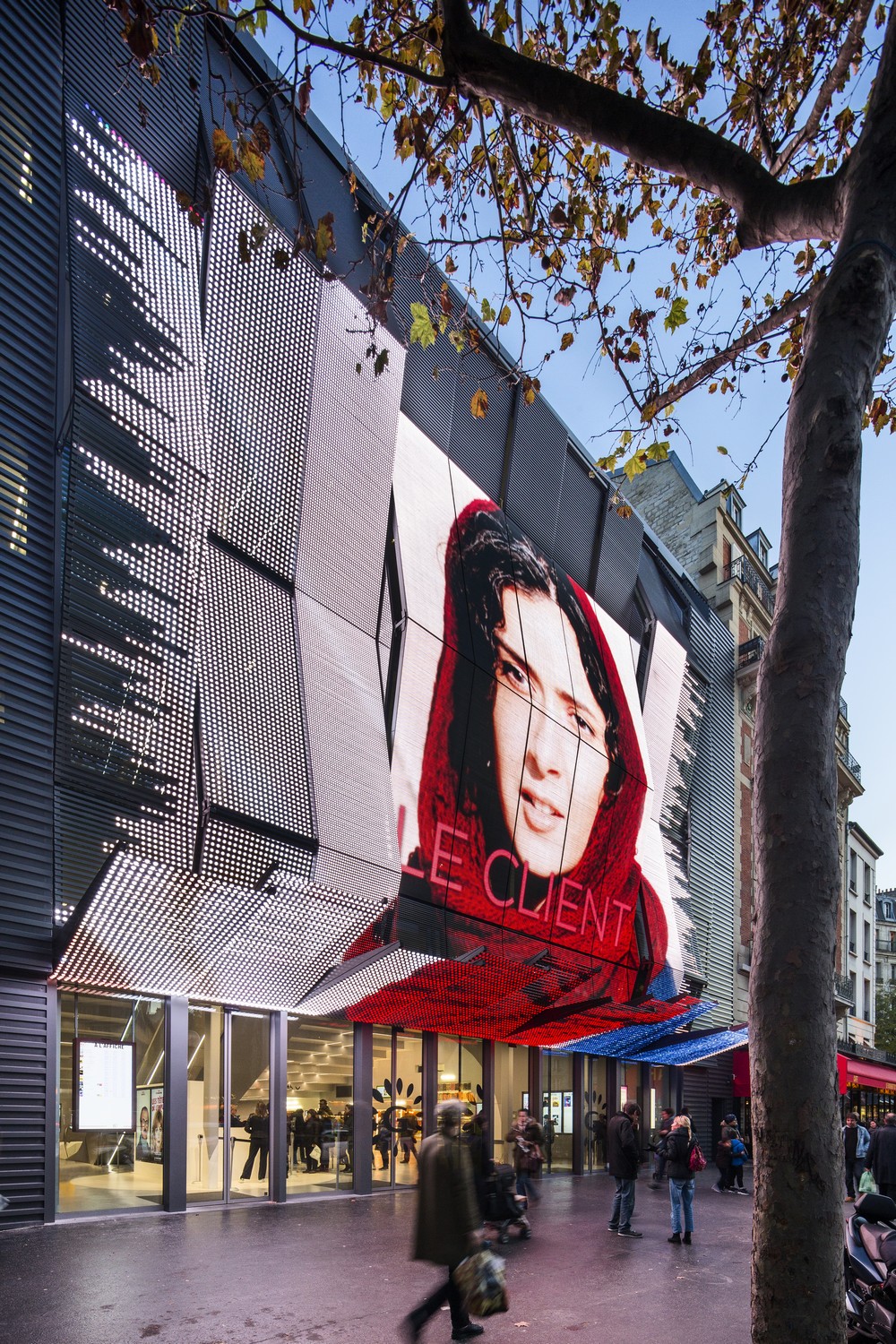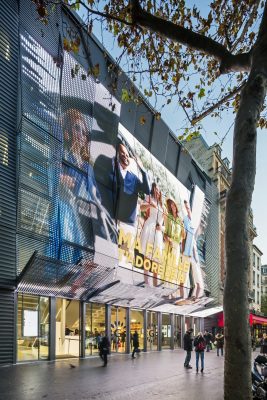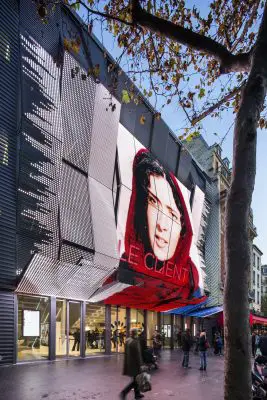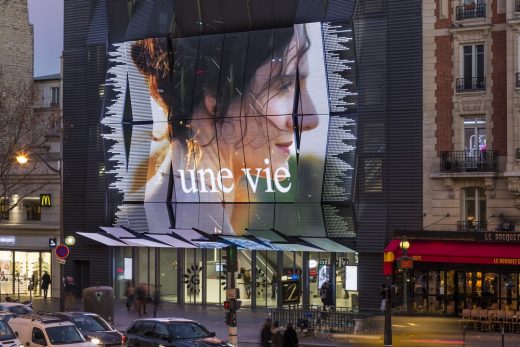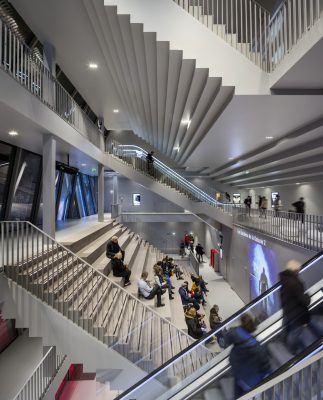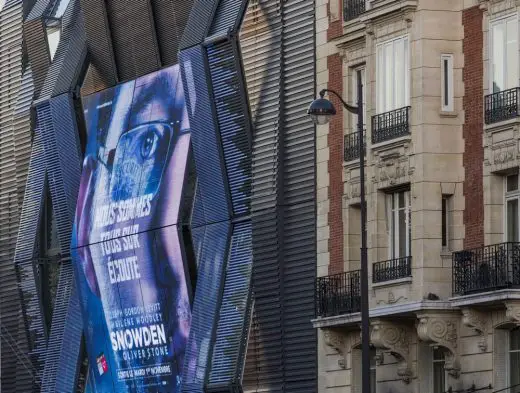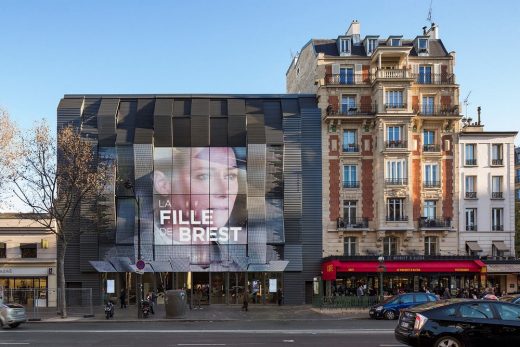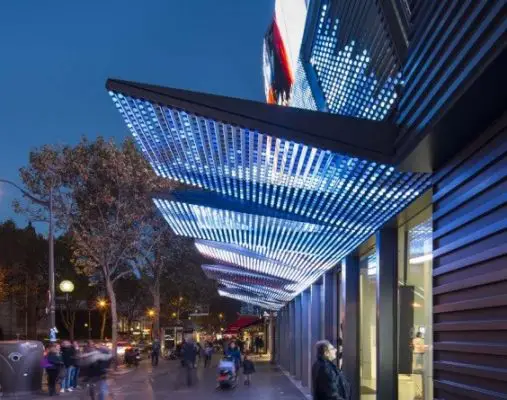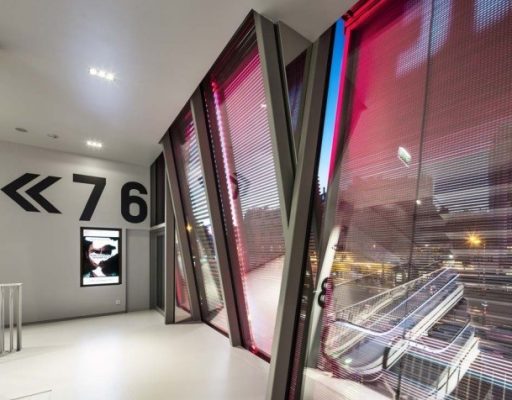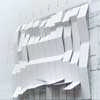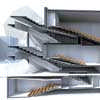New Alesia Cinema Paris, Parisian Theater Building Reconstruction, Photos
New Alesia Cinema in Paris
Paris 14th arrondissement Building design by Manuelle Gautrand architect, France
7 + 6 Mar 2017
New Alesia Cinema in Paris Building
Location: Paris
Architects: Manuelle Gautrand Architecture
A PARIS CINEMA STEEPED IN HISTORY
The project’s concerns:
In 2011, the Gaumont-Pathé group decided to renovate the existing building in order to
upgrade the cinemas and to improve user comfort. This was part of a broader scheme to
gradually update the image of their chain of cinemas, which often occupy exceptional,
city-centre sites, but suffered from being seen as old-fashioned.
Photos below by Luc Boegly
The aim is to transform them into high-quality cultural venues, animated day and night,
and suffi ciently flexible to accommodate a varied programme, mixing cinema with other
cultural events: the image of the city cinema was to be entirely rethought.
Through this project, Gaumont-Pathé aims to open a whole new chapter for its cinema
architecture, a chapter that is contemporary and innovative, where the accent is on
comfort as well as audio and visual quality for the film theatres themselves, but also on
original and generous public spaces for before and after the film.
The site – the context:
The Alésia multi-screen cinema is on the edge of a large urban space. Its main facade
faces due west onto the broad Boulevard du Général Leclerc, a major thoroughfare in
southern Paris. The building now comprises eight screens and occupies a fairly deep site,
with a second facade on the side street, Rue d’Alésia.
The main facade on Boulevard du Général Leclerc is long (about 25 metres), and framed
by two adjacent buildings, very different from one another: a seven-storey apartment
building to the right, a two-storey, mixed-use building to the left.
L’histoire du bâtiment existent:
The history of the building: in constant evolution
On 4 February 1921 a temple to cinema, the ‘Montrouge Palace’, opened to the public on this site. Built entirely in reinforced concrete, audacious for the time, it comprised a single, magnificent, 2800-seat film theatre. In 1930 the Gaumont chain took it over.
In 1951 the building was completely transformed, with a gleaming new cinema inaugurated on 10 October 1951: the new 2000-seat fi lm theatre boasted a large balcony and preserved the majestic reinforced concrete arcades, but lost the boxes on either side of the stage. It was equipped with a large screen to cater for the growing trend of large-format fi lms, which led to the advent of the great ‘CinemaScope’ fi lms in 1953. In the 1960s the cinema shed its ‘Palace’ designation and became simply the ‘Montrouge Gaumont’.
In 1973, like so many others, the large theatre was partitioned into four and the cinema became the ‘Gaumont-Sud’. Screen 1 (900 seats) was made by extending the old balcony, while screens 2 and 3 (400 and 300 seats respectively) were made from the old stalls. The small screen 4, a new, 120-seat theatre, was placed up above In December 1986 a new era began with the transformation to seven screens and, above all, a new sky-blue facade sporting a giant clapperboard.
The new screens 4, 5 and 6 (100, 150 and 150 seats) were made by hiving off space from the rear of screen 1 (reducing its capacity to 520 seats), screens 2 and 3 were untouched, and the old Gaumont-Sud screen 4 became screen 7.
A little anecdote regarding the clapperboard: it was mechanised to clap shut, but in the face of protest from local residents over the noise, was soon immobilised …. The last renovation was completed on 26 May 2004, with the inauguration of a new ‘Gaumont-Alésia’. It involved the complete transformation of all the spaces (screens, halls, circulation…), in line with a new identity for Gaumont cinemas designed by Christian Lacroix. At this point the cinema was given a new facade, less fl amboyant than its predecessor.
Photographs below © Guillaume Guerin:
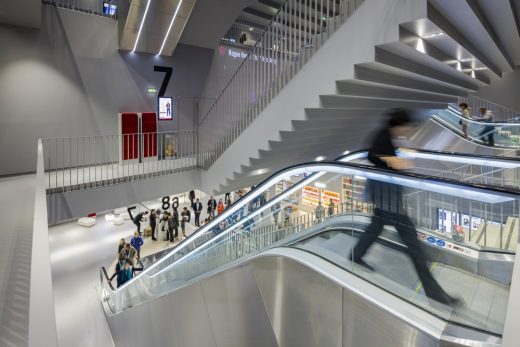
A NEW CINEMA FOR THE 21ST CENTURY
The project has two main aims:
– To showcase the film theatres and visually identify them as physical spaces, as much from within
the building as from without.
– To showcase the films, this time directly on the facade. Here the films themselves, rather than
the theatres, take their place … The facades are covered in a kind of huge curtain of LEDs, which is
used to screen a range of animation: fi lm extracts, stills, colours and abstract images can be used
to bring the facade to life.
These are the means by which the cinema hopes to resume its position within the city: internally,
the architecture aims to display the cinema’s unusual and spectacular volumes, while externally it
envelops itself in fi lm extracts and moving images, which also speak of cinema ….
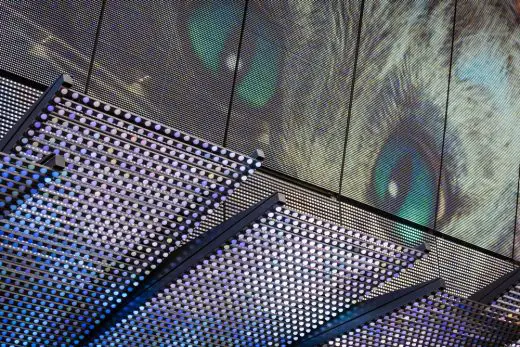
An assembly of theatres, stacked and slotted together
The film theatres are arranged within the building so that virtually every volume is visible and
identifiable. The contents of the project form a sort of vertical sculpture, where the theatres slot
into one another like a puzzle.
The tiered seating in the theatres is made visible on its underside, forming magnificent stepped
ceilings.
These ceilings are then extended into the adjacent space to create partially tiered lobby areas:
little amphitheatres that slope down towards the theatre entrances. These create spaces for
informal projections, supplementary spaces where yet again cinema is present and disseminated.
It is almost as though the stalls in the fi lm theatres had reached out beyond their boundaries to
welcome the public into a universe bathed in fi lm and projections …
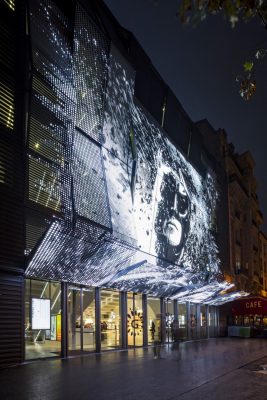
The public is welcomed in a vast space beneath tiers of theatre seating
As already mentioned, the aim was to make the project more fl uid and accessible to all members of
the public: entrance is made via a large hall, which runs the full depth of the building and links the
Boulevard de Général Leclerc directly to the Rue d’Alésia.
Within this vast, light and airy space are all the reception services: fi rst in line from the Boulevard
entrance are ticket sales, an information point, automated ticket and information points and
refreshments, with a seating area and a cafe. Beyond these, to the left, is access to the different
theatres, above and below, and then a quieter space towards the Rue d’Alésia entrance, with areas
for screening films. This sculpted space is tucked into a hollow beneath the tiered seating of one of
the theatres above.
All the circulation interlinks within the majestic, triple-height atrium. A series of escalators and
walkways behind the facade lead to the different mezzanine levels and upper-level theatres. The
public can be seen, and can move around to look at the spaces from below or from above, as well
as enjoying views onto the outside world.
Within this array of stairs, walkways and escalators, large areas of tiered seating are arranged.
These punctuate the public spaces, providing further spaces for sitting and chatting before going
in to see a film.
With their backs to the facade, these little amphitheatres address the fi lm theatre wall, onto which
moving images can be projected and viewed from the banked seating. A sneak preview of the film,
for example …
THE VERY LATEST IN TECHNOLOGY FOR THE PROJECTION ROOMS
A cinema’s standard acoustic challenges come from the need to thoroughly insulate the projection
rooms against internal and external sound, to reduce the background noise from technical
equipment, and to ensure suitably muffl ed internal acoustics in order to provide a true rendition of
the film’s soundtrack.
The Alésia cinema project presents a multitude of specific features that create supplementary
acoustic challenges and generate an increased level of complexity, in particular:
– Several directly adjoining residential buildings needing to be insulated against the high sound
levels generated within the cinemas;
– A mixed structure of concrete and steel, requiring different solutions according to material;
– The client’s stipulation that amongst the eight screens of the new cinema, some should be
equipped with surround sound (3D sound).
The necessary conservation of the original perimeter walls, on which the new structure would
be supported at given points, constituted a major extra acoustic constraint because it created
transmission points of sound and vibration into surrounding buildings.
In order to acoustically isolate the fi lm theatres from one another and from the neighbouring
buildings, the number of structural bearing points was kept to a minimum, and insulating, selfsupporting
cladding was used for the theatre walls and ceilings (ceilings suspended from springs
with acoustic insulation), but also for the fl ooring (fl oating fl oor and tiered seating were isolated on
anti-vibration supports).
The acoustic environment within the fi lm theatres needed to be particularly carefully determined so
as to ensure the correct rendition of the fi lms’ soundtracks and avoid any problems of echo.
Differentiation must be made between the general theatres and the surround-sound theatres.
For the former, the absorbent acoustic materials employed have already been thoroughly tested.
For the latter, the innovative choice of surround-sound in cinemas 3, 5 and 8 requires a specifi c
approach. This system entails the installation of a number of supplementary speakers in the walls
and ceiling (by comparison with standard viewing) in order to obtain optimum 3D audio effect and
the sensation of being plunged into the audio action of the films.
The cinemas:
– 4K projection in the main theatre,
– Dolby Atmos surround sound in the main theatre,
– Digital 7.1 audio and 2K projection in the 7 other theatres,
– numbered seating in all the theatres,
– «duo» seats for couples and «trio» for families,
– free Wi-Fi access throughout the cinema.
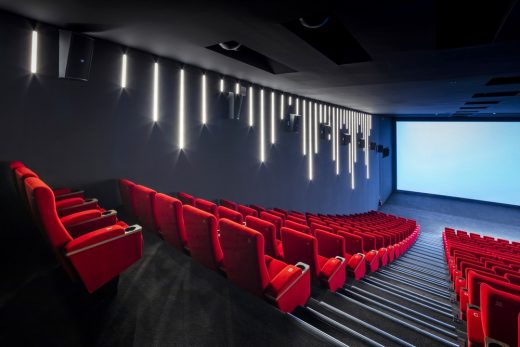
A FACADE LIKE A PLEATED CINEMA SCREEN
Given the urban setting of this project, the main facade on the Avenue du Général Leclerc plays
a vital role: it is virtually right above the Alésia metro exit, giving onto the generously broad
pavement. The maximum authorised height on this section of the street is 21 metres, with a
maximum width of 25 metres; thereby it is more than 500m2 of facade that stands over this very
visible section of the Avenue.
The facade is broken down into into a dozen vertical strips, like ribbons. Each strip supports several
facets, alternately orientated upwards or downwards, as if folded.
In the central area, these great pleats are made of glass and covered in regularly spaced LED
modules, forming a large, animated grid.
Towards the edges of the facade, the large pleats are opaque and formed of metal cladding,
sometimes covered in the same structure of LEDs, sometimes simply folded to maintain the rhythm.
These pleats discretely integrate the constraints imposed by the urban planners: one is not aware
of a lack of continuity between the upper and lower sections of the facade, although fragmented
by successive recesses. Indeed the project is formed of 12 vertical ribbons, each following its own
rhythm of folds.
These ribbons can function either independently of one another, each showing a different picture
from its neighbours, or as a whole, showing one single picture across all the LEDs, thus greatly
increasing the number of different possibilities.
The bottom section in each ribbon folds upwards to form surfaces that are almost horizontal,
creating a vast canopy that overhangs the pavement by some 3 metres. These panels are also
covered in LEDs, providing the public with different images, which are this time almost within
reaching distance.
This gives the public the sensation of walking into the picture as they go into the building.
The facade is principally viewed from outside, but it also constitutes an important feature on the
inside: the various theatre entrances, the foyers, walkways and large areas of tiered seating all
showcase the facade, providing the chance to discover its internal face.
And this facade is just as beautiful from the inside: comprised of large glazed panels protected by
the grid of LEDs, it provides views of the Avenue down below, the church opposite, and also the
sophisticated workmanship of the modules of LEDs affi xed at regular intervals to the grid of parallel
metal supports. At dusk, the luminosity of the LEDs is perceptible from the inside, illuminating the
foyers and circulation spaces with the diffuse colours of the animated images.
The dense arrangement of LED modules also serves as sunscreen for this sunny facade. Solar as well as thermal gain (as the sunscreen is positioned on the outside) are thus reduced. The Rue d’Alésia facade also plays an important role in the project as it too provides access into the cinema, which was not previously the case. The aim is to make these cinemas more visible and welcoming to the neighbourhood, so the Rue d’Alésia entrance is vital.
This facade uses the same themes established on the Avenue du Général Leclerc, but much more discretely: its reduced scale allows for a small surface made up of a few pleated ribbons, but without LEDs.
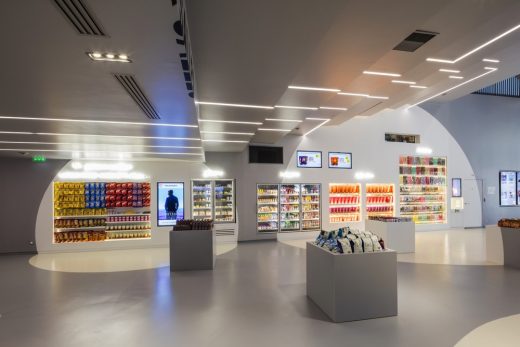
ARCHITECTURE OF LIGHT
By Vincent Thiesson, lighting designer, ON
Integral to the project
Clever installation of the LEDs, which follow the folds of the facade and act as a sunscreen, while also ensuring the transparency between the interior and exterior, has transformed the building into an architecture of light. Like Oscar Nitzchke’s 1936 Maison de la Publicité scheme for the Champs Élysées, the project uses moving light, revisited and adapted to contemporary cinema and communications.
Play and variation of spacing between the LED clusters, or ‘pitches’.
The aim of the project is not to create a rectangular screen, but to display images in a more poetic manner, more like an art installation. To achieve this there is a play on spacing the LED clusters, from 20mm at the centre of the facade, providing a clear, crisp image, to 80mm towards the edges, gradually breaking down the image.
This effect is completed with just occasional clusters around the periphery, giving the impression of light stippling that blurs to nothing in the fold of the metal cladding. Along the lower section the image folds upwards over the canopy, bringing a touch of Broadway to the cinema entrance.
Diffused light
Finished with a translucent cover, the diode is less dazzling and softer, replacing with a diffuse light the blaze of diodes that has invaded so many towns and cities around the world since the advent of this technology. The size of the cover varies from 10mm to 40mm to cater for the variations in pitch, ensuring an even distribution of non-directional lighting.
Technology specific to this architecture
By maintaining the transparency of the facade, particularly at night, it has been possible to give the
impression of an image hung in space. A dark image reveals the soffi ts of the fi lm theatres and the
circulation spaces in the atrium behind; a pale image brings out the folds in the facade.
Careful management of light levels
The use of a cover over each LED cluster on the facade ensures a perfect, even exposure of each
cluster, from any angle of vision up to 180°. This means that the screen intensity can be reduced
to just 5% after night falls. Natural light levels are monitored in order to adjust the luminosity of the
screen.
Technical information:
Number of LED pixel clusters: 229 500
Number of bars: 3730
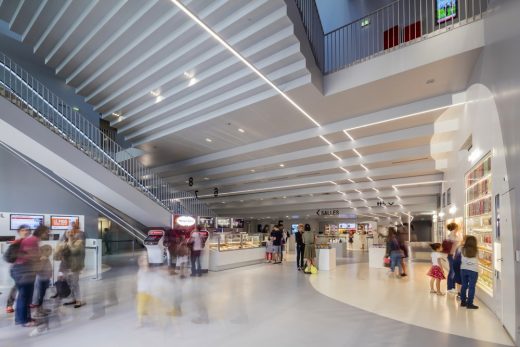
BENEATH THE DIODES, A HUGE GLAZED FACADE
By Tom Gray, founding partner, T/E/S/S
A facade like a cascade of pleated ribbons
The facade is broken down into a dozen vertical ribbons, each of which is composed of a series of
sloping surfaces zigzagging down the facade. At the bottom, above the doors, these ribbons fold
back up on themselves to form a large entrance canopy.
A steel curtain wall
The facade structure is composed of rectangular steel sections that rest on the walkways behind
the facade, onto which they transfer the wind loads. However, these walkways have limited
structural inertia vertically, so all the vertical loads of the facade are transferred down into the
ground at street level. At the top, the structure turns back to form the roof structure.
Here, the rectangular sections are replaced by hot-rolled laminated sections, hidden behind a suspended
ceiling. The stability in the plane of the roof is ensured by crossed wind-bracing, and the in-plane
stability of the facade is ensured by Vierendeel truss action with rigidly fixed connections.
Whole sections of the facade grid, like giant ladders, are prefabricated with welded connections in
modules of transportable size.
The mullions of the facade are doubled up when there is a non-alignment of the facade between
two ribbons. The subsequently exposed sides of the mullions are clad and insulated to prevent
thermal bridges.
Filler panels
The facade is composed of three large panels of glass (1.70m wide by up to 4.7m high), doubleglazed
with a solar coating. The use of large panels of glass reduces the thermal loss of the
building, since thermal loss through the joints in curtain walling is higher than thermal loss through
the double-glazing. As a consequence, by reducing the linear quantity of joints, the U-value of
the building is increased.
The LEDs placed to the exterior of the glass acts as solar shading and
reduces solar gain. The opaque areas of the facade are either opaque insulated panels set into the
curtain walling, or solid rain-screen panels over an insulated concrete wall. Openings for fi reman’s
access are situated within sections clad in solid panels.
LED supports
The U-shaped bars that hold the LEDS are fi xed to a prefabricated frame made from rectangular
steel profi les. In order to clean the glass one must have access behind the LEDs and so every
second panel slides behind the adjacent panel. In order to allow for this movement, the LED panels
in most parts of the facade are organised in alternating vertical strips, which are in different planes.
However, in other sections of the facade the panels are all aligned to allow for a continuous sharp
image, and so one panel in two must translate backwards prior to sliding behind its neighbour. This
complicated mechanism was developed with the contractor through prototypes. The large panels
move on rails that are fi xed to the main curtain walling through blade-like brackets, which are
situated at the level of the fl oor slabs.
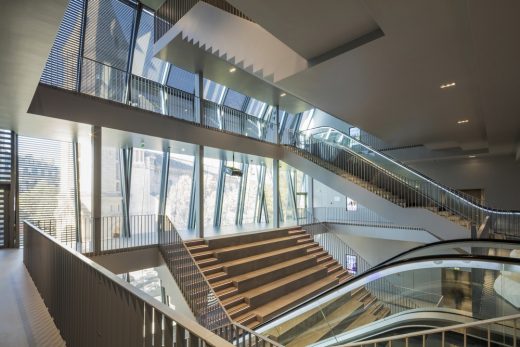
CREDITS:
All photography: © Luc Boegly or © Guillaume Guerin
Drawings, text, plans: © Manuelle Gautrand Architecture
© Manuelle Gautrand Architecture
PROJECT:
Renovation of the ‘Alésia’ cinema
73 Boulevard du Général Leclerc
75014 Paris – France
PROGRAMME:
Eight film theatres with a total of 1380 seats,
ticket hall, atrium space, offices.
ARCHITECT:
MANUELLE GAUTRAND ARCHITECTURE
Manuelle Gautrand, architect
CLIENT:
GAUMONT-PATHÉ
DESIGN TEAM:
ON: lighting design
T/E/S/S: facades
KHEPHREN INGENIERIE: structure
INEX: services and lifts
PEUTZ: acoustics
Photos below by Luc Boegly
OTHER CONSULTANTS:
GETRAP: Project manager, site phase
MAIN CONTRACTORS:
LEON GROSSE: structure, concrete
MBE: roof membranes
SIMCO: facades
OUTDOOR MEDIA: LEDs
SLAM: steelwork
CLIM DESIGN: HVAC – plumbing
IVT: electricity
OTIS: elevators – escalators
BRAD: internal joinery
LINOSONEGGO: seating
HTI: flooring, fabrics
TRANSFORMEURS: fit-out
SICORAP: paintwork, ceilings, partitioning
CONCEPT RESINE: floor resin
FIGURES:
– Building
Gross surface area: 3.600 m²
Cost of works: 12M € ex. VAT
– Cinemas:
4K projection in the main theatre,
Dolby Atmos audio system in the main theatre,
Digital 7.1 audio and 2K projection in the 7 other
theatres.
– LEDs:
Number of LED pixel clusters: 229 500
Number of bars: 3730.
DATES:
– Design: 2011–2014
– Site: 2014–2016
Alésia and Mistral Cinema Theaters Building Paris images / information from Manuelle Gautrand
Manuelle Gautrand – Parisian architecture studio
10 Aug 2012
Alésia and Mistral Cinema Theaters
Location: Paris, France
Architect: Manuelle Gautrand
ALESIA AND MISTRAL CINEMA THEATERS – PARIS – FRANCE
Program: Reconstruction and refurbishment of Alésia and Mistral cinema theaters in Paris 14th arrondissement
Location: Paris, France
New Paris Architecture
Contemporary Paris Architecture
Paris Architecture Design – chronological list
Architecture Tours in Paris by e-architect
Another Parisian building design by Manuelle Gautrand:
C42 – Citroën display building, Champs Elysées, Paris
Architect: Manuelle Gautrand
Citroën display building
Philharmonie de Paris
Ateliers Jean Nouvel
Philharmonie de Paris
lnstitut du Monde Arabe, 1 Rue des Fossés, V
Design: Jean Nouvel Architect
lnstitut du Monde Arabe
Pyramide du Louvre, Ie
I.M. Pei & Partners Architects
Pyramide du Louvre
Musée du quai Branly
Ateliers Jean Nouvel
Musée du quai Branly
Comments / photos for the Alésia and Mistral Cinema Theaters Paris page welcome

